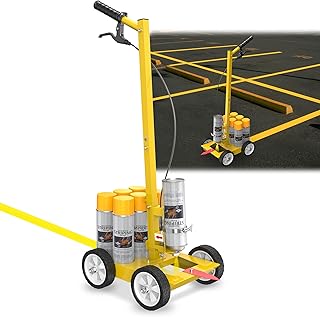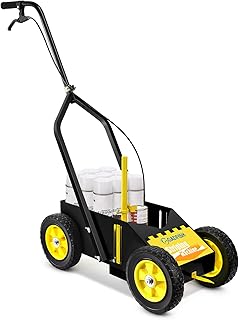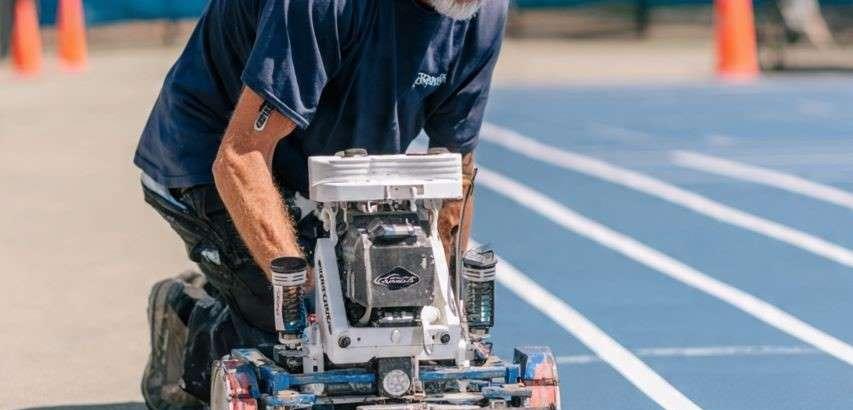A Court Line Striping Machine is a specialized piece of equipment designed to apply precise, straight, and consistent lines onto various athletic surfaces, such as those for basketball, tennis, volleyball, pickleball, and multi-sport courts. It is an essential tool for facility managers, groundskeepers, and painting contractors, replacing the tedious, error-prone process of manual taping and painting with a fast, professional, and repeatable method.
Core Function and Principle
The fundamental principle is straightforward: the machine dispenses paint (or other marking material) through a spray gun in a controlled, continuous stream. A guiding mechanism, often a wheel or a laser, ensures the line is perfectly straight and follows the intended path. The key is the combination of consistent paint flow and precise guidance.
Key Components and Features
Paint Tank/Reservoir:
Function: Holds the marking paint.
Capacity: Typically ranges from 2 to 5 gallons (7.5 to 19 liters), allowing for long, uninterrupted striping sessions.
Pressurization System: This is a critical feature. The tank is pressurized using:
CO2 Tank: A small, disposable or refillable carbon dioxide tank provides a clean, consistent pressure source. This is the professional standard.
Built-in Electric Air Compressor: Common in smaller or more consumer-grade models for convenience.
Manual Pump: Less common, requiring the user to manually pump to build pressure.
Spray Gun and Nozzle:
Function: The point where paint is dispensed. The operator controls the flow with a trigger or lever on the gun.
Nozzle Types: Nozzles are interchangeable to create different line widths (e.g., 1 inch, 2 inches, 5 cm). The nozzle design creates a sharp, fan-shaped spray pattern for clean edges.
Guidance System:
Wheel-Guided System: The most common type. The spray gun is mounted on a boom that is connected to a guide wheel. The user simply rolls the wheel along a string line, a pre-existing line, or the edge of the court, and the spray gun follows the exact same path.
Laser-Guided System: A more advanced and expensive system. A laser beam is projected onto the court surface, and the operator follows the laser line with the machine. This eliminates the need for physical string lines and is excellent for creating new layouts or working on very large fields.
Chassis and Wheels:
Frame: Typically made of steel or aluminum for durability.
Transport Wheels: Larger wheels for moving the machine around the court.
Guide Wheel: A smaller, precise wheel that is the heart of the guidance system.
Hose and Regulators:
Hose: Connects the pressurized tank to the spray gun.
Pressure Regulator: Allows the operator to fine-tune the air pressure, which directly affects the paint flow rate, line consistency, and overspray.
Types of Court Striping Machines
Walk-Behind Machines: The most versatile and common type. The operator walks behind the machine, guiding it along the string line. Ideal for courts of all sizes.
Rider/Truck-Mounted Machines: Used for very large areas like football/soccer fields or running tracks. These are often larger units mounted on a vehicle or a dedicated riding platform.
The Striping Process: Step-by-Step
Surface Preparation: The court must be clean, dry, and free of debris. Any old, flaking paint should be removed.
Layout and String Lining: For new lines or complex layouts, strings are tightly stretched across the court and secured with pins or tape to act as a physical guide. This is the most crucial step for accuracy.
Machine Setup:
Fill the tank with properly mixed paint (often a water-based or latex acrylic formulated for sports courts).
Pressurize the tank to the recommended PSI (usually between 10-40 PSI).
Attach the desired nozzle for the required line width.
Striping:
Position the guide wheel firmly against the string line or existing court edge.
Squeeze the trigger on the spray gun and walk at a steady, consistent pace. The speed of walking determines the thickness and opacity of the line.
Maintain a consistent height and distance from the surface.
Cleanup: Immediately after use, the machine must be thoroughly cleaned with water or an appropriate solvent to prevent paint from drying and clogging the internal passages, hoses, and nozzle.
Advantages and Benefits
Unmatched Precision and Straightness: Produces perfectly straight, professional-quality lines that are difficult or impossible to achieve by hand.
High Efficiency and Speed: Dramatically reduces the time required to line a court compared to manual methods.
Consistency: Ensures every line has the same width, opacity, and appearance.
Reduced Physical Strain: Eliminates the need for bending, kneeling, and tedious taping.
Versatility: With different nozzles, one machine can stripe everything from a badminton court to a soccer field.
Limitations and Considerations
Initial Cost: High-quality professional machines represent a significant investment.
Learning Curve: Achieving perfect results requires practice to master a steady walking speed and consistent trigger control.
Setup Time: The process of laying out string lines, especially for a full court, can be time-consuming.
Maintenance: Requires diligent cleaning and occasional part replacement (e.g., nozzles, O-rings).
Weather Dependence: Striping should only be done in calm, dry conditions with moderate temperatures. Wind can cause overspray, and rain will ruin fresh paint.
The Court Line Striping Machine is a cornerstone of modern athletic facility maintenance. It is a testament to the principle that the right tool for the job transforms a difficult chore into a simple, efficient, and high-quality process. By ensuring crisp, accurate, and durable court markings, it not only enhances the professional appearance of a facility but also directly contributes to the quality of the game played upon it, ensuring athletes have clear and reliable boundaries for competition.
 |  |  |
 |  |  |
